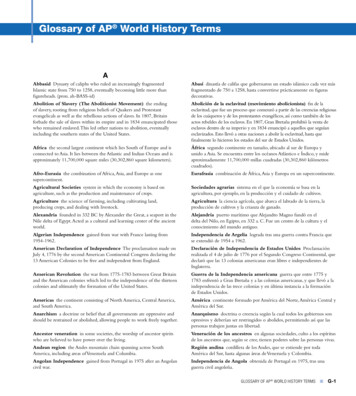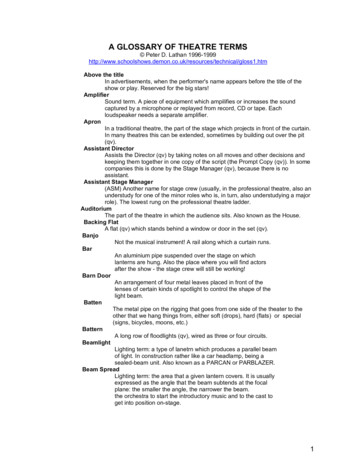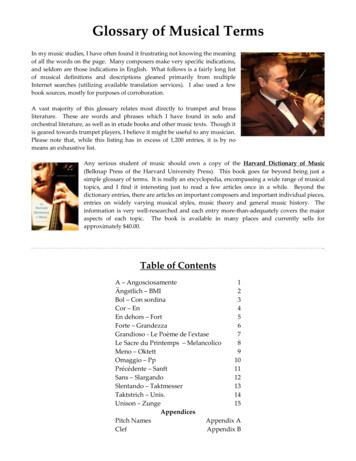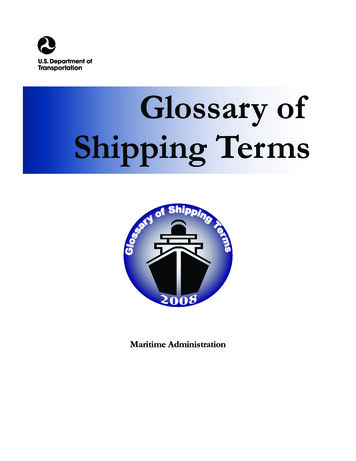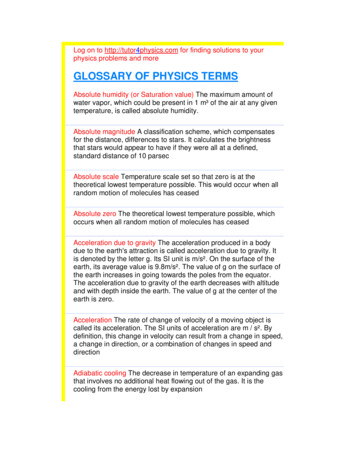
Transcription
Log on to http://tutor4physics.com for finding solutions to yourphysics problems and moreGLOSSARY OF PHYSICS TERMSAbsolute humidity (or Saturation value) The maximum amount ofwater vapor, which could be present in 1 m³ of the air at any giventemperature, is called absolute humidity.Absolute magnitude A classification scheme, which compensatesfor the distance, differences to stars. It calculates the brightnessthat stars would appear to have if they were all at a defined,standard distance of 10 parsecAbsolute scale Temperature scale set so that zero is at thetheoretical lowest temperature possible. This would occur when allrandom motion of molecules has ceasedAbsolute zero The theoretical lowest temperature possible, whichoccurs when all random motion of molecules has ceasedAcceleration due to gravity The acceleration produced in a bodydue to the earth's attraction is called acceleration due to gravity. Itis denoted by the letter g. Its SI unit is m/s². On the surface of theearth, its average value is 9.8m/s². The value of g on the surface ofthe earth increases in going towards the poles from the equator.The acceleration due to gravity of the earth decreases with altitudeand with depth inside the earth. The value of g at the center of theearth is zero.Acceleration The rate of change of velocity of a moving object iscalled its acceleration. The SI units of acceleration are m / s². Bydefinition, this change in velocity can result from a change in speed,a change in direction, or a combination of changes in speed anddirectionAdiabatic cooling The decrease in temperature of an expanding gasthat involves no additional heat flowing out of the gas. It is thecooling from the energy lost by expansion
Adiabatic heating The increase in temperature of compressed gasthat involves no additional heat flowing into the gas. It is heatingfrom the energy gained by compressionAir mass A large, more or less uniform body of air with nearly thesame temperature and moisture conditions throughoutAllotropic forms Elements that can have several different structureswith different physical properties-for example, graphite anddiamond are two allotropic forms of carbonAlpha particle The nucleus of a helium atom (two protons and twoneutrons) emitted as radiation from a decaying heavy nucleus; alsoknown as an alpha rayAlternating current An electric current that first moves one direction,then the opposite direction with a regular frequencyAmp Unit of electric current. It is equivalent to coulomb/sec.Ampere Full name of the unit AmpAmplitude (of waves) The maximum displacement of particles ofthe medium from their mean positions during the propagation of awave is called the amplitude of the wave.Amplitude (of an oscillation) The maximum displacement of a bodyfrom its mean position during an oscillatory motion is called theamplitude of oscillation.Angle of incidence Angle of an incident (arriving) ray or particle to asurface; measured from a line perpendicular to the surface (thenormal)Angle of reflection Angle of a reflected ray or particle from asurface; measured from a line perpendicular to the surface (thenormal)
Angular Acceleration The rate of change of angular velocity of abody moving along a circular path is called its angular acceleration.Angular acceleration is denoted by a.Angular Displacement The angle described at the center of thecircle by a moving body along a circular path is called angulardisplacement. It is measured in radians.Angular Momentum Quantum Number From quantum mechanicsmodel of the atom, one of four descriptions of the energy state ofan electron wave. The quantum number describes the energysublevels of electrons within the main energy levels of an atomAngular Velocity The rate of change of angular displacement iscalled angular velocity.Astronomical unit The radius of the earth's orbit is defined as oneastronomical unit (A.U.)Atom The smallest unit of an element that can exist alone or incombination with other elementsAtomic mass unit Relative mass unit (u) of an isotope based on thestandard of the carbon-12 isotope, which is defined as a mass ofexactly 12.00 u; one atomic mass unit (I u) is 1/12 the mass of acarbon-12 atomAtomic number The number of protons in the nucleus of an atomAtomic Weight Weighted average of the masses of stable isotopesof an element as they occur in nature, based on the abundance ofeach isotope of the element and the atomic mass of the isotopecompared to carbon-12Avogadro's Number The number of carbon-12 atoms in exactly12.00 g of C that is 6.02 x 10 23 atoms or other chemical units. It isthe number of chemical units in one mole of a substanceAxis The imaginary line about which a planet or other object rotates
Background Radiation Ionizing radiation (alpha, beta, gamma, etc.)from natural sourcesBalanced Forces When a number of forces act on a body, and theresultant force is zero, then the forces are said to be resultantforces.Balmer series A set of four line spectra, narrow lines of coloremitted by hydrogen atom electrons as they drop from excitedstates to the ground stateBarometer An instrument that measures atmospheric pressure,used in weather forecasting and in determining elevation above sealevelBeat Rhythmic increases and decreases of volume fromconstructive and destructive interference between two sound wavesof slightly different frequenciesBeta particle High-energy electron emitted as ionizing radiationfrom a decaying nucleus; also known as a beta rayBig bang theory Current model of galactic evolution in which theuniverse was created from an intense and brilliant explosion from aprimeval fireballBinding energy The energy required to break a nucleus into itsconstituent protons and neutrons; also the energy equivalentreleased when a nucleus is formedBlack hole The theoretical remaining core of a supernova that is sodense that even light cannot escapeBlackbody radiation Electromagnetic radiation emitted by an idealmaterial (the blackbody) that perfectly absorbs and perfectly emitsradiationBohr model Model of the structure of the atom that attempted tocorrect the deficiencies of the solar system model and account forthe Balmer series
Boiling point The temperature at which a phase change of liquid togas takes place through boiling. It is the same temperature as thecondensation pointBoundary The division between two regions of differing physicalpropertiesBritish thermal unit The amount of energy or heat needed toincrease the temperature of one pound of water one degreeFahrenheit (abbreviated Btu)Cathode rays Negatively charged particles (electrons) that areemitted from a negative terminal in an evacuated glass tubeCelsius scale of temperature In the Celsius scale of temperature,the ice-point is taken as taken as the lower fixed point (0 deg C )and the steam-point is taken as the upper fixed point (100 deg C).The interval between the ice point and steam point is divided into100 equal divisions. Thus, the unit division on this scale is 1degC.This scale was earlier called the centigrade scale. 1 deg C 9/5deg F.Centigrade Alternate name for the Celsius scaleCentrifugal force An apparent outward force on an object followinga circular path that. This force is a consequence of the third law ofmotionCentripetal force The force required to pull an object out of itsnatural straight-line path and into a circular path; centripetal meansChain reaction A self-sustaining reaction where some of theproducts are able to produce more reactions of the same kind; in anuclear chain reaction neutrons are the products that produce morenuclear reactions in a self-sustaining seriesCircular Motion The motion of a body along a circular path is calledcircular motion.
Coefficient of cubical expansion The increase in volume of asubstance per unit original volume per degree rise in temperature iscalled its coefficient of cubical expansion. The SI unit of coefficientof cubical expansion is K-1.Coefficient of linear expansion The increase in length per unitoriginal length per degree rise in temperature is called thecoefficient of linear expansion. The SI unit of the coefficient of linearexpansion is K-1.Compression A part of a longitudinal wave in which the density ofthe particles of the medium is higher than the normal density iscalled a compression.Compressive stress A force that tends to compress the surface asthe earth's plates move into each otherCondensation (sound) A compression of gas molecules; a pulse ofincreased density and pressure that moves through the air at thespeed of soundCondensation (water vapor) Where more vapor or gas moleculesare returning to the liquid state than are evaporatingCondensation nuclei Tiny particles such as tiny dust, smoke, soot,and salt crystals that are suspended in the air on which water
condenses condensation point the temperature at which a gas orvapor changes back to a liquidCondensation point the temperature at which a gas or vaporchanges back to a liquidConduction The transfer of heat from a region of highertemperature to a region of lower temperature by increased kineticenergy moving from molecule to moleculeConstructive interference The condition in which two waves arrivingat the same place, at the same time and in phase, add amplitudesto create a new waveControl rods Rods inserted between fuel rods in a nuclear reactorto absorb neutrons and thus control the rate of the nuclear chainreactionConvection Transfer of heat from a region of higher temperature toa region of lower temperature by the displacement of high-energymolecules-for example, the displacement of warmer, less dense air(higher kinetic energy) by cooler, denser air (lower kinetic energy)Conventional current Opposite to electron current-that is, considersan electric current to consist of a drift of positive charges that flowfrom the positive terminal to the negative terminal of a batteryCoulomb Unit used to measure quantity of electric charge;equivalent to the charge resulting from the transfer of 6.24 billionparticles such as the electronCoulomb's law Relationship between charge, distance, andmagnitude of the electrical force between two bodiesCovalent bond A chemical bond formed by the sharing of a pair ofelectronsCovalent compound Chemical compound held together by acovalent bond or bonds
Crest The point of maximum positive displacement on a transversewave is called a crest.Critical angle Limit to the angle of incidence when all light rays arereflected internallyCritical mass Mass of fissionable material needed to sustain achain reactionCurvilinear Motion The motion of a body along a curved path iscalled curvilinear motion.Cycle A complete vibrationDe-acceleration See retardationDecibel scale A nonlinear scale of loudness based on the ratio ofthe intensity level of a sound to the intensity at the threshold ofhearingDestructive interference The condition in which two waves arrivingat the same point at the same time out of phase add amplitudes tocreate zero total disturbance. (also see constructive interferenceDew point temperature The temperature at which condensationbeginsDew Condensation of water vapor into droplets of liquid on surfacesDiffraction The bending of light around the edge of an opaqueobjectDiffuse reflection Light rays reflected in many random directions, asopposed to the parallel rays reflected from a perfectly smoothsurface such as a mirrorDirect current An electrical current that always moves in onedirection
Direct proportion When two variables increase or decrease togetherin the same ratio (at the same rate)Dispersion The effect of spreading colors of light into a spectrumwith a material that has an index of refraction that varies withwavelengthDisplacement The change in the position of an object in a particulardirection is called displacement. Displacement may also be definedas the shortest distance between the initial and final position of amoving body. It is a vector quantity.Distance The actual length of the path traveled by a bodyirrespective of the direction is called the distance traveled. It is ascalar quantity.Doppler effect An apparent shift in the frequency of sound or lightdue to relative motion between the source of the sound or light andthe observerEcho A reflected sound that can be distinguished from the originalsound, which usually arrives 0.1 sec or more after the originalsoundElastic strain An adjustment to stress in which materials recovertheir original shape after a stress is releasedElectric circuit Consists of a voltage source that maintains anelectrical potential, a continuous conducting path for a current tofollow, and a device where work is done by the electrical potential;a switch in the circuit is used to complete or interrupt theconducting pathElectric current The flow of electric charge electric field force fieldproduced by an electrical chargeElectric field lines A map of an electric field representing thedirection of the force that a test charge would experience; thedirection of an electric field shown by lines of force
Electric generator A mechanical device that uses wire loopsrotating in a magnetic field to produce electromagnetic induction inorder to generate electricityElectric potential energy Potential energy due to the position of acharge near other chargesElectrical conductors Materials that have electrons that are free tomove throughout the material; for example, metalsElectrical energy A form of energy from electromagneticinteractions; one of five forms of energy-mechanical, chemical,radiant, electrical, and nuclearElectrical force A fundamental force that results from the interactionof electrical charge and is billions and billions of times stronger thanthe gravitational force; sometimes called theElectrical insulators Electrical nonconductors, or materials thatobstruct the flow of electric currentElectrical nonconductors Materials that have electrons that are notmoved easily within the material-for example, rubber; electricalnoncon
definition, this change in velocity can result from a change in speed, a change in direction, or a combination of changes in speed and direction Adiabatic cooling The decrease in temperature of an expanding gas that involves no additional heat flowing out of



